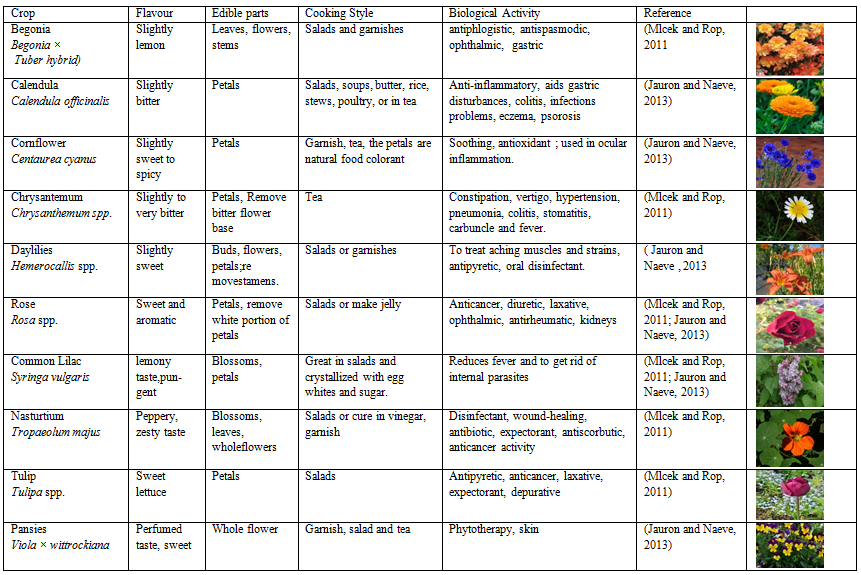Authors: Dr. Vanlalruati, Dr. Prativa Anand and Dr. Gunjeet Singh
Division of Floriculture and Landscaping
ICAR-IARI, New Delhi-110012
Email : maruathmar@gmail.com
The culinary use of flowers can be traced back as far as 140 B.C. The tradition of using flowers for cooking is an important part of the Romans, Chinese, Middle Eastern and Indian cultures. In Ancient Rome, the edible flowers of violets and roses were used in dishes, and lavender was used in sauces. Use of rose petals in dishes and sweets was popular during the Victorian era and dandelions were one of the bitter herbs referred to in the Old Testament of the Bible. Edible flowers are obtained from 97 families, 100 genera and 180 species worldwide (Lu et al., 2016). They aids in color, fragrance and flavor to food such as salads, soups, entrees, desserts and drinks. Hemerocallis disticha (Tai and Chen, 2000), Justicia adhatoda, Nyctanthus arbortristis (Deka and Nath, 2014), Antigonon leptopus,Bougainvillea hybrida, Clitorea ternatea, Cosmos sulphureus and Malvaviscus arboreus were important cuisine in China, India and Thailand respectively (Kaisoon et al., 2011). The flowers are mainly consumed fresh but can also be consumed dried, in cocktails (in ice cubes), canned in sugar and preserved in distillates (Mlcek and Rop, 2011). Pansy (Viola × wittrockiana), centaurea ( Centaurea cyanus), borago (Borago officinalis), rose (Rose spp.), nasturtiums (Tropaeolum majus) and hibiscus (Hibiscus rosa-sinensis) are some of edible flowers that are normally used to garnish dishes. Marjoram (Origanum majorana), and common sage ( Salvia officinalis) were used to improve the flavor of dishes. Petals of tulip, chrysanthemum, Rosa spp. or the flower buds of daisies or garden nasturtium were often consumed raw. There are also several reports on nutritional and health benefits of ornamental flowers.
All parts of the flower except the petals should be removed as pollen may cause an allergic reaction and could affect the flavor. The bitter white base of the petals from chrysanthemums, dianthus, marigolds, and roses should also be removed. Fresh edible flowers are used as a garnish or in salad and quash flowers are fried in light batter or cornmeal. After harvesting, long stemmed flowers are placed in water and then in a cool location. Within three or four hours of using, short stemmed flowers should be placed between layers of damp paper toweling or in a plastic bag in the refrigerator. Flowers should be gently washed before use and checked for insects or soil. Wilted flowers should be placed into a bowl of ice water for 30-60 seconds and then drain on paper towels.
Growing Edible Flowers
Edible flowers may vary from annuals, biennials, perennials, trees, shrubs, and vines. Some flowers, such as the prolific nasturtium, are annuals, while others, like roses, are perennials. Most annuals need to be replanted each year and seed is dispersed by wind. Biennials can be cut back during their offseason and division and planting is done as an when required. Biennials have a lengthy flowering period unlike annuals whereas most perennials display peak blossoms for a two or three week period. Vines can be an annual, shrubs or trees and flowers anually. For growing edible flowers, pesticides approved for only edible crops should be used. Most flowers require a nutrient rich, well-drained soil with a pH around 5.5 to 6.5.
Mulching (2-3 inch) can be done to reduce weeds, conserve soil moisture, maintain uniform soil temperatures, and reduce the amount of soil splashed onto the plant during heavy rain. Although adequate moisture is important for flower growth, overhead sprinklers can physically damage the delicate petals, and the wet foliage is more susceptible to foliar disease. Drip irrigation is advised to minimise muddy splashes on the flowers.
Table: Characteristics and biological activities of important Edible Flowers

Preserving Edible Flowers
Edible flowers can be candied; frozen in ice cubes to be added to beverages; made into jellies, jams, teas, or wines; and included in vinegars for cooking, marinades, or salad dressings. They can also be dried for future use and stored in an airtight container in a cool dark place.
Harvesting Flowers
The optimum time for harvest of petals is when flowers are in peak bloom. Blossoms should be picked during the early morning or late evening in cool to enhance storage and for high sugar content. Flowers can be wrapped in plastic and refrigerated for later use and floated on ice water to enhance freshness. Most edible flowers grow well in containers, including nasturtium, pansies, violas, marigolds and most herbs.
Conclusions
Despite the potential health benefits associated to edible flowers consumption, attention must be given to their harvest and preservation aspect due to their high perishability. There is a global demand regarding longer shelf life and safety, it is necessary to study potentialities of new food-processing technologies such as HHP, which will not only maintain the quality of the product longer but also enhance producers incomes.
Reference
Lu, B., Li, M., Yin, R., 2016. Phytochemical content, health benefits, and toxicology of common edible flowers, a review (2000–2015). Crit. Rev. Food Sci. Nutr. 56 (Suppl 1), 130–148.
Deka, K., Nath, N., 2014. Documentation of edible flowers of western Assam. Am. J. Phytomed. Clin. Ther. 2 (10), 1124–1140.
Gardner Z, McGuffin M, eds. American Herbal Products Association’s Botanical Safety Handbook. 2nd ed. Boca Raton, FL: CRC Press; 2013.
Kaisoon, O., Siriamornpun, S., Weerapreeyakul, N., Meeso, N., 2011. Phenolic compounds and antioxidant activities of edible flowers from Thailand. J. Funct. Foods 3 (2), 88–99.
Mlcek, J., Rop, O., 2011. Fresh edible flowers of ornamental plants – a new source of nutraceutical foods. Trends Food Sci. Technol. 22 (10), 561–569.
Jauron, R., Naeve, L., 2013. Edible Flowers. Iowa State University extension and Outreach https.//store.extension.iastate.edu/Product/Edible-Flowers.
Stradley L. Edible flowers are the new rage in haute cuisine. What’s Cooking America website. http://whatscookingamerica.net/ EdibleFlowers/EdibleFlowersMain.htm. Accessed February 27,2015.
Tai, C.Y., Chen, B.H., 2000. Analysis and stability of carotenoids in the flowers of Daylily (Hemerocallis disticha) as affected by various treatments. J. Agric. Food Chem. 48 (12), 5962–5968.
About Author / Additional Info: